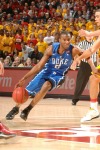The NCAA men’s basketball tournament, known as “March Madness,” is renowned for its Cinderella stories and big upsets.
The 10th-seeded Gonzaga Bulldogs captured the sports world in 1999 when they knocked off second-seed Stanford and sixth-seeded Florida to advance to the Elite Eight. And then there is the George Mason Patriots.
In 2006, the Patriots went on one of the most improbable runs in tournament history, advancing to the Final Four as a No. 11 seed.
Unless your name is George Mason, if you want to make the Final Four, you better play for a team in one of the “power conferences.”
The six power conferences (ACC, Big East, Big 10, Big 12, Pac-10 and SEC) dominate the field of the Final Four every season. Since the last of the power conferences, the Big 12, came into existence in 1997, every National Champion has come from one of the six.
Not only that, but an astounding 91 percent (40 out of 44 through 2008) of Final Four teams came from the power conferences.
From 2005 to 2010, the power conferences received 199 of the 384 bids to the tournament.
The most bids went to the Big East who average seven bids per year. Next were the Big 12, Big 10 and ACC with 5.5 bids per year and the Pac-10 and SEC with about 5 bids per year.
An evaluation of how these conferences did during the tournament cannot be based simply on how many bids each conference got or which conference has won the most National Championships.
One of the ways to value the conferences is to calculate the actual record of each conference during the tournament and compare it against the expected record of that conference.
The expected record is determined by the seed each team receives.
In other words, if every team with a better seed won their matchups, the expected record would be the actual record — so a No. 2 seed has an expected record of 3-1 because it is expected to win its first three games against teams seeded 15, 7 and 3, but lose to the No. 1 seed in the regional final.
Meanwhile, a No. 11 seed has an expected record of 0-1 because it faces a higher seeded team, a No. 6, in the first round.
While this will not be able to put the age-old argument to rest as to what conferences are over or under rated, this imperfect barometer does provide an interesting tool for evaluating whether a conference has historically been over or under seeded by the Selection Committee.
Using the actual and expected records for each of the power conferences over the last six tournaments for historical reference, I have evaluated whether each of the power conferences will outperform or underperform the seeds they were given in this year’s tournament.
I will revisit the actual record of each power conference after a National Champion has been crowned to see how I did.
1. BIG 10 CONFERENCE
Tournament Bids: 7
Expected Record: 10-7
 The Big 10 Conference is one of only two power conferences who have exceeded their expected record over the past six tournaments. However, the conference has also gone without a National Championship since Michigan State won it all in 2000.
The Big 10 Conference is one of only two power conferences who have exceeded their expected record over the past six tournaments. However, the conference has also gone without a National Championship since Michigan State won it all in 2000.
This year the overall No. 1 seed in the Tournament, Ohio State, is considered the favorite to cut down the nets in Houston. Behind the nation’s top freshmen, Jared Sullinger, and an experienced sharp-shooting backcourt, it would be tough to imagine a Final Four without the Buckeyes being a part of it. In March anything can happen, but pencil the Ohio State University into the National Championship game in your brackets and thank me later.
The next tier of teams out of the Big 10 feature the No. 3 seed Purdue Boilermakers and the No. 4 seed Wisconsin Badgers.
Led by a pair of seniors, JaJuan Johnson and E’Twaun Moore, the Boilers will have to overcome their lack of depth in the front court when they matchup against two Big East teams in Georgetown and Notre Dame. In their 13th consecutive trip to the dance, the Badgers look to avoid the upset against a solid Belmont team. Despite solid play for most of the year, a deep run is not in the cards for Wisconsin this year.
No. 8 seed Michigan and No. 9 seed Illinois could win their opening round matchups, but will not survive the first weekend of the Tournament. It is tough to ever count out Tom Izzo and the No. 10 seed Michigan State Spartans, but the Spartans will have to pull it together if they want to make a run in this tourney. With a potential national champion and two other teams who have a legitimate chance to reach the Elite Eight, the Big 10 gets my nod as the conference most likely to exceed expectations over the next three weeks.
2. SOUTHEASTERN CONFERENCE
Bids: 5
Expected Record: 6-5
 In the last six years, the SEC has lived up to their seeding by not only exceeding their expected record as a conference but pulling in two National Championships along the way. The expectations for the SEC were down this year with only two teams emerging as elite, Kentucky and Florida.
In the last six years, the SEC has lived up to their seeding by not only exceeding their expected record as a conference but pulling in two National Championships along the way. The expectations for the SEC were down this year with only two teams emerging as elite, Kentucky and Florida.
But Selection Committee must have gotten confused when they put the Gators on the two line and the Wildcats on the four line. After all, UK beat Florida two out of three times with the third coming in a convincing 16 point win in the SEC Championship game. But let’s not get too caught up in the questionable decisions of the Selection Committee.
The Gators received a favorable schedule in the Southwest region with a matchup against UCLA or Michigan State for an opportunity to advance to the Sweet Sixteen. Florida’s likely opponent would then be the BYU Cougars, a team that lost their top two big-men late this season. Expect Florida’s big men, Vernon Macklin and Chandler Parsons, to dominate inside and offset the explosive Jimmer Fredette just enough to advance to the Elite 8.
While No. 9 seed Tennessee could take down No. 8 Michigan, a win over Duke in the second-round is highly unlikely. No. 5 Vanderbilt is on upset alert as they take on the experienced No. 12 seed Richmond Spiders. As expected, even if Vandy escapes the first round, they will not have enough to get by Pitino’s Louisville squad to advance to the Sweet Sixteen.
Look for the SEC to once again match or slightly exceed their expected record, but don’t look for a Final Four team to emerge from this group.
3. BIG 12 CONFERENCE
Seed: 5
Expected Record: 9-5
 Despite having the second worst actual record as compared to its expected record, the Big 12 comes in as the third best conference for the 2011 tournament. The Big 12’s expected record over the last six tournaments was 55-33 (.625), but their actual record was 48-32 (.600). Despite this poor track record, the Big 12 appears poised to outperform their seeds this year.
Despite having the second worst actual record as compared to its expected record, the Big 12 comes in as the third best conference for the 2011 tournament. The Big 12’s expected record over the last six tournaments was 55-33 (.625), but their actual record was 48-32 (.600). Despite this poor track record, the Big 12 appears poised to outperform their seeds this year.
In the 15 year history of the Big 12 Conference, the Kansas Jayhawks have won or shared the regular-season title in 11 of those seasons.
Kansas has been considered one of the most talented teams in the country all year and it looks to put the early round exit from last year behind them when they open play against No. 16 Boston University. Potential hiccups for Kansas in the Southwest region include Big East foes Louisville, Georgetown and Notre Dame.
The Jayhawks have a legitimate opportunity to advance for the Final Four and make a run for their fourth National Championship.
Many believe the Texas Longhorns deserved a better seed than No. 4. However, their play down the stretch left much to be desired. The Longhorns have Final Four talent, but of late have lacked the killer instinct necessary to make a run deep into March.
Look for sophomore Jordan Hamilton to show some leadership and lead the Longhorns to the Elite Eight this year.
Midway through the season, many wrote off No. 5 seed Kansas State, but with the re-emergence of senior guard Jacob Pullen the Wildcats seemed poised to live up to their preseason hype. A tough matchup against No. 12 seed Utah State has cooled some of that talk. No. 7 seed Texas A&M plays a physical brand of basketball, but their lack of offensive talent will send the Aggies home early.
With Kansas lurking as a potential National Champion and Texas set to make a run at a Final Four berth, expect the Big 12 to make a strong showing.
4. PACIFIC 10 CONFERENCE
Bids: 4
Expected Record: 3-4
 The Pac-10 has the lowest winning percentage of any of the power conferences during the last six tournaments. Despite that, the conference has won one National Championship and has performed on par with their expected record consistently throughout the last six years. The Pac-10 received an unexpected four bids into the tournament when USC snuck in as one of the “last-four” on Selection Sunday.
The Pac-10 has the lowest winning percentage of any of the power conferences during the last six tournaments. Despite that, the conference has won one National Championship and has performed on par with their expected record consistently throughout the last six years. The Pac-10 received an unexpected four bids into the tournament when USC snuck in as one of the “last-four” on Selection Sunday.
The regular season conference champion Arizona Wildcats makes their 27th NCAA Tournament appearance as a No. 5 seed in the West region. After an opening round win the Cats and Pac-10 Player of the Year, Derrick Williams, will have their hands full with No. 4 seed Texas Longhorns.
The Washington Huskies come into the tournament with a little momentum. After wins against Washington State and Oregon, the Huskies finished off an impressive run through the Pac-10 Tournament with a thrilling overtime win over Arizona to clinch the championship.
The Huskies hope that success carries over to the NCAA Tournament as it did last year when the No. 11 seed advanced to the Sweet Sixteen. After a favorable opening round matchup with the Georgia Bulldogs, the Huskies would face a road game against the No. 2 seed, North Carolina Tar Heels, in Charlotte, NC.
If the UCLA Bruins can impose their will on the defensive end of the floor and dominate inside with their bigs, they have a chance to string together a win or maybe even two.
5. ATLANTIC COAST CONFERENCE
Bids: 4
Expected Record: 8-4
 Despite winning three National Championships in the last six seasons, according to the expected record, the ACC has underperformed in recent history. The conference has gone 49-30 (.620) while their expected record over those tournaments was 63-33 (.636). Once again the conference has received two high seeds in this tournament and expectations are high.
Despite winning three National Championships in the last six seasons, according to the expected record, the ACC has underperformed in recent history. The conference has gone 49-30 (.620) while their expected record over those tournaments was 63-33 (.636). Once again the conference has received two high seeds in this tournament and expectations are high.
As usual, the Duke Blue Devils and North Carolina Tar Heels dominated the Atlantic Coast Conference this year. The Blue Devils look to duplicate their improbable run through the NCAA Tournament last year when they captured their fourth National Championship.
Despite their No. 1 seed, Duke does not have enough of an inside presence to survive again. Point-guard Nolan Smith should lead the Dukies to the Sweet Sixteen, but a matchup with either Arizona or Texas will be too much.
After a shaky start to the season, the Tar Heels righted the ship in capturing the ACC regular season championship and a No. 2 seed. The East region was not the best draw for North Carolina as they face potential matchups with Washington, Syracuse and Ohio State.
If the Tar Heels are to make a deep run freshman Harrison Barnes will have to live up to the expectations that were bestowed on him when he was named a preseason All-American prior to taking a single collegiate shot.
The No. 10 seed Florida State Seminoles and the No. 12 seed Clemson Tigers have the potential to win their opening round matchups, however, anything more than that is highly unlikely.
The two high seeds out of this conference will have a decent tournament, but will not be able to live up to their expected records.
6. BIG EAST CONFERENCE
Bids: 11 (NCAA record)
Expected Record: 18-11
![]() I know most of you are shocked to find the Big East at the bottom of this list. But consider this, despite receiving 82 bids into the tournament over the last six years, the Big East has not had a National Champion since UConn in 2004 and has only sent three teams to the Final Four.
I know most of you are shocked to find the Big East at the bottom of this list. But consider this, despite receiving 82 bids into the tournament over the last six years, the Big East has not had a National Champion since UConn in 2004 and has only sent three teams to the Final Four.
Moreover, during that time period the Big East has performed the worst out of any of the power conferences when comparing their actual record (61-43 – .587) to their expected record (82-43 – .656). And it wasn’t even close.
Perhaps a demanding schedule against a top-heavy roster of likely tournament teams leaves contenders worn out by the time the brackets are announced. This will be put to the test when No. 3 seed, UConn, takes the floor on Thursday, only four days after completing a stretch of five games in five days against the best the conference has to offer.
There is no doubt that the Big East Conference was the deepest and most dominant conference in the country this year, reflected by the conference’s record eleven bids. The previous record was eight bids by the Big East in 2010, 2008 and 2006. Regular season success does not always translate to success in the NCAA Tournament, however.
Other Big East teams appear to have been worn down during conference play this season including No. 11 seed, Villanova, finishing 5-10 in their last 15 games.
Both St. John’s and Georgetown enter the tournament banged up. The Red Storm lost their third-leading scorer (10.7 ppg) and leading rebounder (5.7 rpg), forward D.J. Kennedy, to an ACL injury in their opening game in the Big East Tournament.
While the Hoyas expect to get point guard Chris Wright back for their opening game against the winner of USC or VCU, it is yet to be determined how effective he can be after being out for nearly a month. Wright suffered a fractured bone in his left hand Feb. 23 in the Hoyas’ loss to Cincinnati.
With a second round matchup with No. 3 seed, Purdue, looming, the outlook for the Hoyas is bleak.
Syracuse, Notre Dame and Pittsburgh must have success in this Tournament in order for the Big East to live up to the lofty expectations that has been set for the conference.
Pitt received a No. 1 in the weakest region in the Tournament, the Southwest. However, the Panthers have a lot to prove considering they have only beaten one team seeded sixth or better in the tournament, Xavier in 2009 in the Sweet Sixteen. Anything less than two Final Four teams out of this conference has to be considered a disappointment.
It looks like history will repeat itself here as the expectations have again been set too high for the Big East. The conference will have a difficult time living up to the seeds the selection committee dealt them.
Stay tuned for a recap of the 2011 men’s NCAA Tournament to find out whether each of these power conferences lived up to their expected records.
